Table of Contents
Nowadays, companies have begun to recognize the importance of employee onboarding. An Increasingly larger number of businesses develop entire programs for introducing new hires to the company and helping them get started.
On average, a business spends about $1500 to onboard a new employee. However, when we talk about onboarding, a better word would be “invest”, because the resources that the company allocates to help the new colleague acclimatize are likely to bring multiple benefits.
Proper onboarding increases employee retention. 69% of workers that were offered a structured onboarding program remained with the company for at least three years. For the business, this is a direct benefit - it gets an experienced, highly productive professional and does not have to invest in training new people.
How knowledge management assists in onboarding
On their first day on a new job, employees come with their professional skills already tested and evaluated. Thus, onboarding is not as much about training as about introduction and getting to know each other. More specifically, onboarding pursues the following goals:
- Introduce the new hire to the team, their duties and responsibilities, the ways of working, and daily routines.
- Explain the regulatory procedures ensuring compliance with both internal and external rules of the company.
- Describe the company culture, values, vision, and commitments that create a healthy working environment.
- Assist the new colleague in making connections with other team members and coworkers.
In order to achieve these goals, the company needs to develop a comprehensive onboarding program. It usually starts with an HR representative greeting the newcomer and often offering branded gifts and then proceeds to an introduction to the company including both mentor-led activities and self-service resources.
Mentors, or “buddies”, support new employees in learning the ways of working, actively introduce them to procedures, policies, and routines, and connect them with other colleagues.
However, a large share of onboarding activities can be self-paced, when the new worker uses the company’s knowledge management resources to learn both the general policies and procedures and specific details related to their everyday work. Such learning can have many formats:
- Knowledge base - a storage of the company’s knowledge.
- Self-training sessions with or without final quizzes.
- Video tutorials.
An effective knowledge management system can bring multiple benefits to the onboarding process.
1. Readily available access to the company information
For someone who is not familiar with the way information is stored and shared within the company, it may be difficult to search for things they need at the beginning of their work journey. By introducing them to the general principles of knowledge organization, the company makes information search more transparent and clear.
With a properly set up knowledge management system, new hires may find answers to many of their questions independently, without a need to reach out to their mentors or other subject-matter experts. On the one hand, this speeds up the onboarding process, on the other hand, allows using both the new employee’s and the experts’ time more efficiently.
2. Self-paced learning
Just like 40% of customers that prefer self-service resources, new hires might also find an advantage in getting to know their new place of employment at their own pace. They can take their time familiarizing themselves with the structure of the company’s knowledge, make the necessary notes, and bookmark pages that might be useful for them in the future.
However, for effective self-learning, the knowledge management system must be properly organized and configured. For example, the following features may make the new employee’s experience much better:
- Advanced search engine that allows filtering information by keywords, tags, file types, etc.
- Clear organization.
- Multi-platform support allowing the user to browse the self-service resources from a desktop or a mobile device.
3. Quicker onboarding
A good knowledge management platform can help new employees start working independently faster. This way, people do not need to memorize procedures or policies or do multiple drills, because they know they can always look up the information they need.
For the business, it is a clear advantage. The sooner the new person gets to their “cruising altitude”, the better. Besides, quicker onboarding allows the company to relieve mentors and SMEs from “chaperoning” the new hire and have them fully engaged in their primary job duties.
4. Team collaboration opportunities
Establishing connections with other employees is an important part of the onboarding program, as it lays the foundation for future collaboration. A knowledge management system can offer discussion topics that can grow into collaboration and team-building opportunities for the new hire.
A new person views the existing knowledge storage with a fresh set of eyes and might have some improvement suggestions that everybody else has missed.
In addition, if they need guidance from their more experienced colleagues, newcomers can start the conversation already armed with the knowledge they found while browsing the company’s resources. As a result, the discussion becomes more focused.
5. Lower risk of miscommunication
Information stored in the company’s knowledge base is always more reliable than information shared verbally or jotted down on a piece of paper. In a conversation, you can mishear or misinterpret something, which can affect further work.
When, however, you get guidance from a knowledge base, you can be sure about its correctness and completeness. Moreover, you can always go back to it, if necessary.
Besides, a knowledge management system is a great channel for broadcasting team- or company-wide updates. Whenever a procedure or policy changes, everyone can be informed immediately through an update of the knowledge base.
10 best knowledge management systems to check out in 2024
Let’s look at the most popular knowledge management software on the market today.
1. Notion
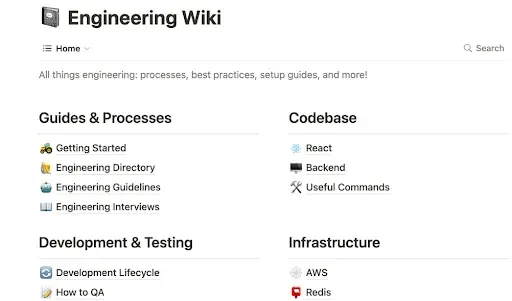
Notion is more than just a knowledge management platform. With this tool, you are getting a complete solution for knowledge, project, and documentation management, which also includes a set of templates for you to use. This way, Notion can be considered a complete workspace that is also perfectly suitable for employee onboarding.
Notable features
- Connected workspace enabling multiple project and knowledge management activities - task tracking, planning, scheduling.
- Multiple file format support.
- Mobile version.
- File sharing.
Pros
- Smooth learning curve
- Affordable pricing plans including a free tier
- AI support
Cons
- No reporting featuresLimited communication optionsLimited mobile app functionalitySmooth learning curve
- Affordable pricing plans including a free tier
- AI support
Rating
Pricing structure
Notion’s pricing starts with a free plan, however, with a rather limited set of features. For extended functionality, Notion offers plans at $8 or $15 per user per month. The company also supports custom enterprise plans upon request.
Case studies
Capgemini leveraged the Notion features to create project databases storing vast company data and a project management platform. The tool allowed the company to boost innovation and productivity of its development teams and streamline the project flows.
Companies using Notion
- Duolingo
- Makespace
- Figma
- Adobe
2. Document360

Document360 can be your go-to solution in everything related to documentation. You can use the tool to create product documentation, online help pages, FAQs, and internal knowledge bases, and customize them according to your preferences. Document360 supports rich content creation functionality for teams of any size - from solo users to enterprise customers.
Notable features
- Content creation features including review, activity tracking, and categorization.
- Integration with multiple third-party applications, such as chatbots, translation tools, analytical services, etc.
- Platform API allowing you to connect to Document360 from within your environment.
Pros
- Scalability
- Availability of a free tier
- Intuitive navigation
Cons
- No mobile version
- Paid options are rather pricey
- Limited support options
Rating
Pricing structure
Document360 offers a tiered pricing structure with subscriptions charged per project. It includes a free tier with a basic set of features and paid plans ranging from $149 to $599 per project per month.
Case studies
Better Life Partners, a lifestyle and healthcare company, chose Document360 to host and create treatment documentation. Since healthcare documentation is considered extremely sensitive, it is subject to additional security and privacy measures, which Document360 provided with confidence.
Companies using Document360
- McDonald’s
- Payoneer
- VMware
- Virgin Red
- Ticketmaster
3. Confluence
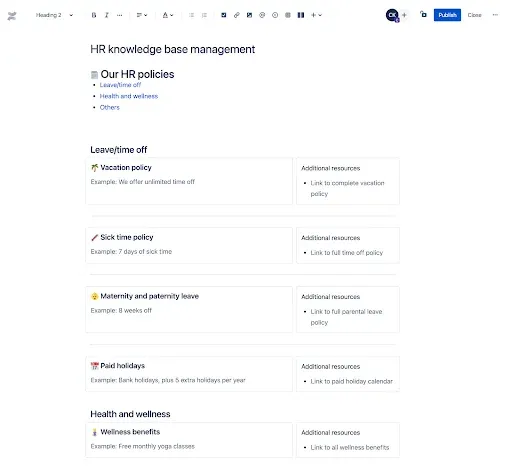
Confluence is known for its superb collaboration options. In it, you can do anything from project planning, activity tracking, task management to documentation maintenance and personal notes. The tool has a great search functionality allowing users to browse content easily.
Confluence integrates with multiple apps - Jira, the issue tracking tool, is the most popular - thus building a complete workspace with project and knowledge management under a single umbrella.
Notable features
- Availability of multiple documentation templates for different areas of business.
- Support of team workspaces with permission-based access.
- Rich text editor.
Pros
- Mobile version for iOS and Android devices
- Availability of a free tier
- Feedback and discussion support
Cons
- Content formatting may be difficult
- Premium plans are rather costly
- Non-intuitive functionality
Rating
Pricing structure
Confluence pricing consists of several tiers starting with a free one and ranging up to an enterprise plan negotiable on a case-by-case basis. The available features differ depending on the pricing level.
Case studies
Lucid Software takes advantage of the vast Confluence functionality to create documentation, runbooks, call logs, and other content that the company uses internally. The company uses cloud-based Atlassian tools leveraging the availability, scalability, and cost-efficiency of cloud products.
Companies using Confluence
- Pfizer
- Samsung
- Delta Airlines
- Dropbox
- Venmo
4. Guru
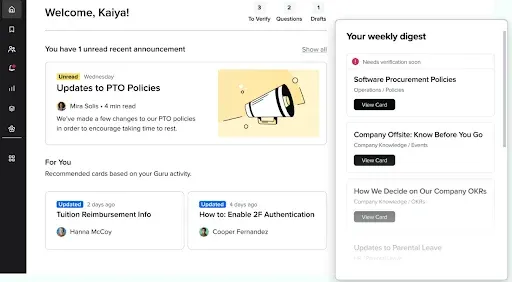
Guru is a flexible content management system that you can use to build an internal wiki or knowledge base. Guru-based resources are highly searchable and implement AI functions to support direct questions and answers.
With Guru, you can create personalized dashboards and receive content recommendations, which makes it a perfect tool for employee onboarding.
Notable features
- Wide content creation options.
- Integration with Slack.
- Powerful analytical features.
- Flexible customization.
Pros
- Knowledge verification features
- Availability of a free tier
- Content organization options
Cons
- No mobile support
- Paid plans may be rather costly for a large number of users
- May become overwhelming as the information base grows
Rating
Pricing structure
Guru offers two standard pricing plans - free and $10 per user per month. For those wishing to get a custom scaleable plan, the company is willing to negotiate an enterprise proposal.
Case studies
Splash chose Guru as its knowledge management platform with the goal of arming the sales team with the most up-to-date information. With Guru, sales reps waste no time finding the knowledge they need, thus improving the team productivity and customer satisfaction.
Companies using Guru
- Intercom
- Shopify
- Noom
- Qualia
- Glint
5. Zoho Desk

Zoho Desk is more of a helpdesk platform than a knowledge management tool. However, it includes its own office suite allowing you to create various types of documents, and this is what earned Zoho a place in this list.
Together with Zoho WorkDrive, office applications form a complete set of tools for documentation management and collaboration. The company knowledge created and stored in Zoho WorkDrive can be a great source of self-learning material for new colleagues.
Notable features
- Shared workspace for team collaboration.
- Industry-standard security.
- Support of various content types - text, spreadsheets, and slideshows.
- Customization options.
Pros
- Flexible integration with third-party apps
- 15-day free trial
- Availability of a mobile version
Cons
- Steep learning curve
- Limited set of features at low pricing levels
- Limited size of file uploads
Rating
Pricing structure
Zoho Desk’s pricing plans range from €14 to €40 per user per month, depending on the features you would like to get. All pricing tiers offer a free trial period when you can test the tool and see if it works for you.
Case studies
Lakeside CNC Group, Inc. uses Zoho Desk to run its growing database of customer inquiries and completed services. The tools allowed the repair business to improve the visibility of its records and streamline processes, thus increasing productivity.
Companies using Zoho Desk
- Daimler
- McAfee
- Shiji
- Essilor
- Freedonomics
6. HelpCrunch
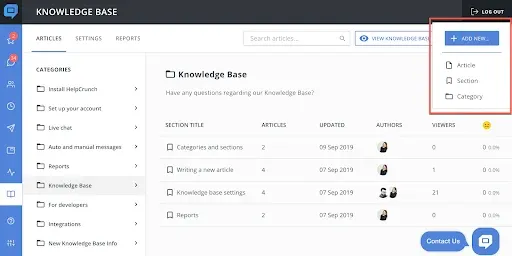
While its main focus is customer service, HelpCrunch supports broad opportunities of creating and managing company knowledge, for both internal and external use. The platform offers a number of templates that you can edit in an intuitive WYSIWYG manner as well as flexible customization options.
A knowledge base created using the HelpCrunch functionality is highly searchable and transparent, which makes it a great onboarding resource.
Notable features
- Easy editing process.
- Support for different types of media files.
- User-friendly collaboration options.
Pros
- Easy learning curve
- Affordable pricing plans with a 14-day free trial
- Availability of a mobile version and a set of APIs for seamless integration
Cons
- Analytic features are rather basic
- Low pricing levels offer only a basic set of features
- Lack of a desktop app
Rating
Pricing structure
HelpCrunch offers a tiered pricing structure with the lowest tier charged at 12$ per user per month and the highest tier - at $495 per month with an unlimited number of users. All tiers have a free trial period to see if HelpCrunch is the right tool for you.
Case studies
Fitlap leveraged HelpCrunch features to bring additional personalization to customer communication. With an effective live chat feature and advanced messaging automation, the business maintains contact with customers, thus increasing engagement and loyalty.
Companies using HelpCrunch
- Rekola
- Hurma
- Revenuegrid
- SE Ranking
- Freedonomics
7. ProProfs Knowledge Base Software
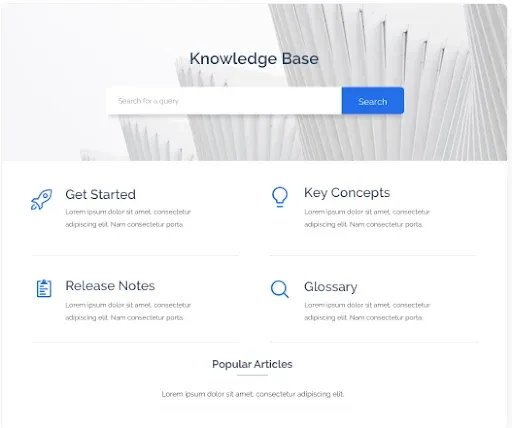
A member of the ProProfs family of tools, ProProfs Knowledge Base Software is a great solution for building and managing information portals for both customers and employees. You can use it to create all sorts of documentation - wikis, user manuals, product guides, FAQs, etc.
Flexible customization options allow producing branded content complying to the company’s standards. Knowledge bases built using ProProfs tools are highly searchable and organizable, thus creating amazing user experiences.
Notable features
- Single-source authoring that allows reusing content.
- Multi-language support.
- Support of various media types, such as images and videos.
Pros
- Easy-to-use, clutter-free interface
- 15-day free trial
- Mobile, desktop, and web versions
Cons
- Very basic set of templates
- Only one pricing plan available
- Performance issues on mobile devices
Rating
8. Scribe
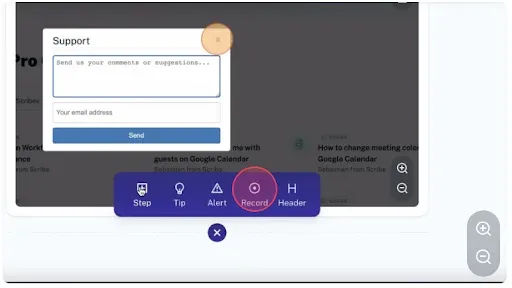
Scribe is different from other tools in this list because it is not about writing documentation. Rather, it is a tool for capturing the processes in a graphic format and creating step-by-step guides. You can record whatever you are doing and then edit the captured footage by adding tips, rearranging steps, and merging several recordings into one.
Notable features
- Video and audio capture.
- Image editing.
- Collaboration options.
Pros
- Intuitive and easy capturing process
- Free pricing tier available
- Great experience for both creators and users
Cons
- Capture editing is somewhat difficult
- Advanced features available only in the Pro tier
- The tool is new and still immature
Rating
Pricing structure
Scribe offers three pricing plans - free for personal use, $12 per user per month for small teams, and custom pricing for enterprises. For custom pricing, you need to contact your sales representative to negotiate the conditions.
Case studies
Talon.One leveraged Scribe features to accelerate new hires' onboarding. With Scribe, it takes minutes to produce new content-rich onboarding materials that help new employees get started.
Companies using Scribe
- Netflix
- IBM
- Verizon
- Samsung
9. ServiceNow

ServiceNow is a multi-component cloud platform designed to automate various organizational processes, which includes knowledge management. The primary focus of ServiceNow is customer service, therefore, knowledge management is also based on incidents or feedback reported by customers. Such an approach allows for identifying gaps in the knowledge and creating articles to fill them.
Notable features
- Content creation based on the incident context.
- Reusable content blocks.
- Subscription to articles with update notifications.
Pros
- Integration with third-party solutions
- Broad customization options
- Effective content organization
Cons
- Limited reporting functionality
- No public prices available
- Complex workflow configuration
Rating
Pricing structure
ServiceNow uses custom pricing that is available upon request. The company prefers not to publish its pricing structure.
Case studies
Capita Software uses ServiceNow in its customer support flows. The business places emphasis on self-service offering customers a community forum, a portal to log issues, and an extensive knowledge base. As a result, the productivity of the service team improved considerably.
Companies using ServiceNow
- Fujitsu
- Kraft Heinz
- Scania
- Accenture
- Siemens
10. ClickUp
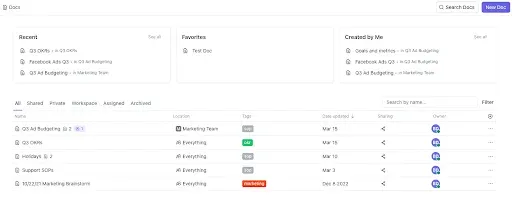
Another project management platform, ClickUp also supports a documentation management tool, called a Doc Hub, that can serve as the company’s knowledge management system. Documents are organized as cards enabling easy search and browsing. Doc Hub supports collaboration options, such as commenting and sharing documentation content.
Notable features
- Rich styling options.
- Connection of documents to workflows.
- Template collection saving document creation time.
Pros
- Great process automation options
- Affordable pricing including a free tier
- Integration with third-party tools
Cons
- Somewhat steep learning curve
- Lack of offline functionality
- Occasional performance issues
Pricing structure
ClickUp pricing includes several tiers - a free tier for personal use, small- and medium-size team plans at $7 and $12 per user per month, respectively, and custom pricing for enterprises.
Case studies
Pigment increased onboarding efficiency with ClickUp facilitating access to the necessary resources and enabling easy communication between employees. For the company, ClickUp became a unified collaborative platform allowing management of multiple business flows.
Rating
Companies using ClickUp
- Mayo Clinic
- Booking.com
- Logitech
- Finastra
- Salesforce
Conclusion
We hope you found our analysis of knowledge management software useful. The main recommendation is to base your choice of tools on your needs. While building your employee onboarding program, note down the knowledge management features you would like to have - and these notes will point to the tool that is the most suitable for you.


